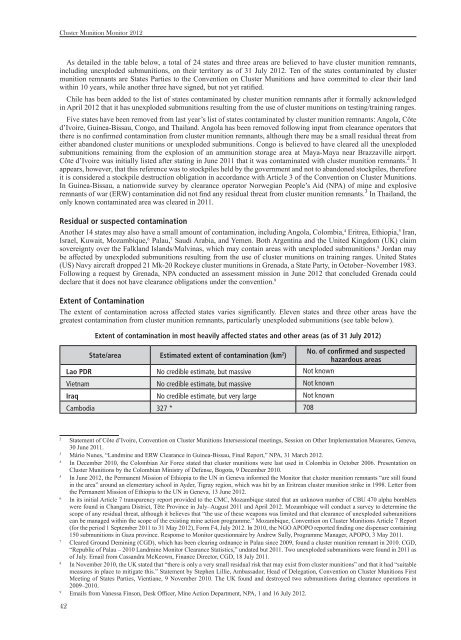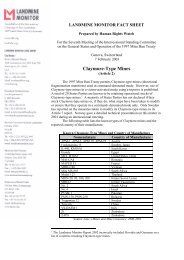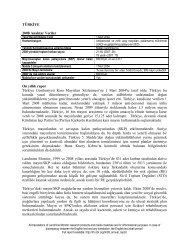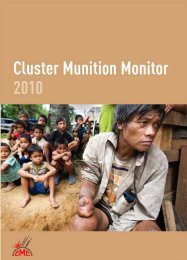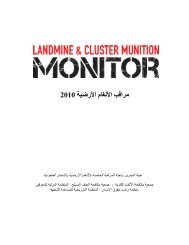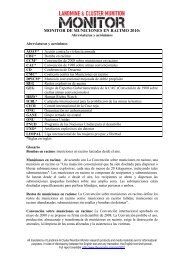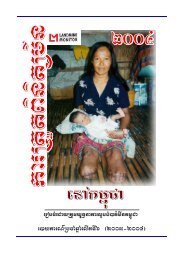Download PDF - Landmine and Cluster Munition Monitor
Download PDF - Landmine and Cluster Munition Monitor
Download PDF - Landmine and Cluster Munition Monitor
Create successful ePaper yourself
Turn your PDF publications into a flip-book with our unique Google optimized e-Paper software.
<strong>Cluster</strong> <strong>Munition</strong> <strong>Monitor</strong> 2012<br />
As detailed in the table below, a total of 24 states <strong>and</strong> three areas are believed to have cluster munition remnants,<br />
including unexploded submunitions, on their territory as of 31 July 2012. Ten of the states contaminated by cluster<br />
munition remnants are States Parties to the Convention on <strong>Cluster</strong> <strong>Munition</strong>s <strong>and</strong> have committed to clear their l<strong>and</strong><br />
within 10 years, while another three have signed, but not yet ratified.<br />
Chile has been added to the list of states contaminated by cluster munition remnants after it formally acknowledged<br />
in April 2012 that it has unexploded submunitions resulting from the use of cluster munitions on testing/training ranges.<br />
Five states have been removed from last year’s list of states contaminated by cluster munition remnants: Angola, Côte<br />
d’Ivoire, Guinea-Bissau, Congo, <strong>and</strong> Thail<strong>and</strong>. Angola has been removed following input from clearance operators that<br />
there is no confirmed contamination from cluster munition remnants, although there may be a small residual threat from<br />
either ab<strong>and</strong>oned cluster munitions or unexploded submunitions. Congo is believed to have cleared all the unexploded<br />
submunitions remaining from the explosion of an ammunition storage area at Maya-Maya near Brazzaville airport.<br />
Côte d’Ivoire was initially listed after stating in June 2011 that it was contaminated with cluster munition remnants. 2 It<br />
appears, however, that this reference was to stockpiles held by the government <strong>and</strong> not to ab<strong>and</strong>oned stockpiles, therefore<br />
it is considered a stockpile destruction obligation in accordance with Article 3 of the Convention on <strong>Cluster</strong> <strong>Munition</strong>s.<br />
In Guinea-Bissau, a nationwide survey by clearance operator Norwegian People’s Aid (NPA) of mine <strong>and</strong> explosive<br />
remnants of war (ERW) contamination did not find any residual threat from cluster munition remnants. 3 In Thail<strong>and</strong>, the<br />
only known contaminated area was cleared in 2011.<br />
Residual or suspected contamination<br />
Another 14 states may also have a small amount of contamination, including Angola, Colombia, 4 Eritrea, Ethiopia, 5 Iran,<br />
Israel, Kuwait, Mozambique, 6 Palau, 7 Saudi Arabia, <strong>and</strong> Yemen. Both Argentina <strong>and</strong> the United Kingdom (UK) claim<br />
sovereignty over the Falkl<strong>and</strong> Isl<strong>and</strong>s/Malvinas, which may contain areas with unexploded submunitions. 8 Jordan may<br />
be affected by unexploded submunitions resulting from the use of cluster munitions on training ranges. United States<br />
(US) Navy aircraft dropped 21 Mk-20 Rockeye cluster munitions in Grenada, a State Party, in October–November 1983.<br />
Following a request by Grenada, NPA conducted an assessment mission in June 2012 that concluded Grenada could<br />
declare that it does not have clearance obligations under the convention. 9<br />
Extent of Contamination<br />
The extent of contamination across affected states varies significantly. Eleven states <strong>and</strong> three other areas have the<br />
greatest contamination from cluster munition remnants, particularly unexploded submunitions (see table below).<br />
Extent of contamination in most heavily affected states <strong>and</strong> other areas (as of 31 July 2012)<br />
State/area Estimated extent of contamination (km 2 )<br />
Lao PDR No credible estimate, but massive Not known<br />
Vietnam No credible estimate, but massive Not known<br />
Iraq No credible estimate, but very large Not known<br />
Cambodia 327 * 708<br />
No. of confirmed <strong>and</strong> suspected<br />
hazardous areas<br />
2<br />
Statement of Côte d’Ivoire, Convention on <strong>Cluster</strong> <strong>Munition</strong>s Intersessional meetings, Session on Other Implementation Measures, Geneva,<br />
30 June 2011.<br />
3<br />
Mário Nunes, “<strong>L<strong>and</strong>mine</strong> <strong>and</strong> ERW Clearance in Guinea-Bissau, Final Report,” NPA, 31 March 2012.<br />
4<br />
In December 2010, the Colombian Air Force stated that cluster munitions were last used in Colombia in October 2006. Presentation on<br />
<strong>Cluster</strong> <strong>Munition</strong>s by the Colombian Ministry of Defense, Bogota, 9 December 2010.<br />
5<br />
In June 2012, the Permanent Mission of Ethiopia to the UN in Geneva informed the <strong>Monitor</strong> that cluster munition remnants “are still found<br />
in the area” around an elementary school in Ayder, Tigray region, which was hit by an Eritrean cluster munition strike in 1998. Letter from<br />
the Permanent Mission of Ethiopia to the UN in Geneva, 13 June 2012.<br />
6<br />
In its initial Article 7 transparency report provided to the CMC, Mozambique stated that an unknown number of CBU 470 alpha bomblets<br />
were found in Changara District, Tête Province in July–August 2011 <strong>and</strong> April 2012. Mozambique will conduct a survey to determine the<br />
scope of any residual threat, although it believes that “the use of these weapons was limited <strong>and</strong> that clearance of unexploded submunitions<br />
can be managed within the scope of the existing mine action programme.” Mozambique, Convention on <strong>Cluster</strong> <strong>Munition</strong>s Article 7 Report<br />
(for the period 1 September 2011 to 31 May 2012), Form F4, July 2012. In 2010, the NGO APOPO reported finding one dispenser containing<br />
150 submunitions in Gaza province. Response to <strong>Monitor</strong> questionnaire by Andrew Sully, Programme Manager, APOPO, 3 May 2011.<br />
7<br />
Cleared Ground Demining (CGD), which has been clearing ordnance in Palau since 2009, found a cluster munition remnant in 2010. CGD,<br />
“Republic of Palau – 2010 <strong>L<strong>and</strong>mine</strong> <strong>Monitor</strong> Clearance Statistics,” undated but 2011. Two unexploded submunitions were found in 2011 as<br />
of July. Email from Cass<strong>and</strong>ra McKeown, Finance Director, CGD, 18 July 2011.<br />
8<br />
In November 2010, the UK stated that “there is only a very small residual risk that may exist from cluster munitions” <strong>and</strong> that it had “suitable<br />
measures in place to mitigate this.” Statement by Stephen Lillie, Ambassador, Head of Delegation, Convention on <strong>Cluster</strong> <strong>Munition</strong>s First<br />
Meeting of States Parties, Vientiane, 9 November 2010. The UK found <strong>and</strong> destroyed two submunitions during clearance operations in<br />
2009–2010.<br />
9<br />
Emails from Vanessa Finson, Desk Officer, Mine Action Department, NPA, 1 <strong>and</strong> 16 July 2012.<br />
42


